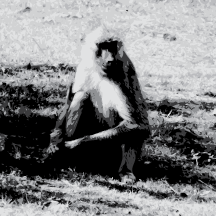I am a budding researcher interested in primate evolution. While a large portion of my past research has taken place on the computer or in the laboratory, I consider myself primarily a field biologist and, therefore, a member of a small but staunch subset of the general population that is willing to spend inordinate amounts of time in some of the most wild, sometimes dangerous, often exhilarating areas of the world, all in the name of science.
As an undergraduate, I spent three weeks following mantled howler monkeys in a tropical dry forest in Nicaragua and two months working with lowland woolly monkeys of the Amazonian rainforest in Ecuador. While these experiences produced some unforgettable moments, I returned home wishing that I had paid more attention to the “forgettable” aspects of fieldwork, things that I never mentioned only because they were overshadowed by other happenings in the field. Months after returning, however, I find it increasingly difficult to communicate the experience of doing fieldwork without a good record of these moments, which leads me to wonder whether I ever got a point across in the first place.
This blog, therefore, is an effort to keep a record of my life as a field primatologist. I should note, however, that I am at most 25% a fieldworker; all other times, I am a student in the U.S. and will likely be writing about other topics, some of them related, some of them not. At heart, though, this is a blog about living in the field. I hope you enjoy it, be sure to leave lots of comments, and thanks for stopping by!


 RSS
RSS
Hi Kenny,
Four of us, Dick Thorington, John Koprowski, Mike Steele, and I, are writing a book, Squirrels of the World, to be published by the Johns Hopkins University Press. We are hoping to illustrate every species account with a photograph, but finding appropriate illustrations is proving to be a challenge. We came across your photo of the Amazon squirrel (http://kennychiou.com/blog/page/2/) and are interested in seeking your permission to use it in the book.
The Press has a permission form, which we will send to you if you are willing to let use the photograph. Unfortunately, we have no budget for the photographs. Royalties will be used for research and education.
Thank you for your time.
Thanks,
Jim